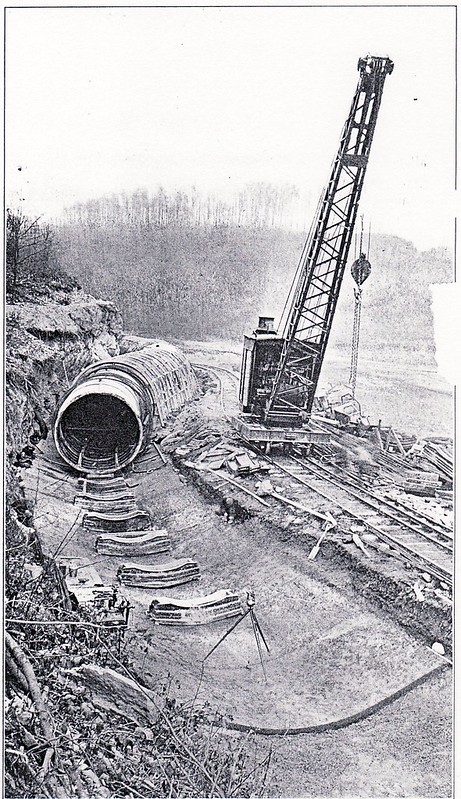
Home > NYC Reports > 1910
By the end of 1910 New York City had acquired all of the land that would become the Kensico Reservoir. Design of the temporary dikes progressed during the year. On the Bronx Dike, which sat (and still sits underwater) to the west of the peninsula, the overflow spillway (called a waste channel) was designed and modifications were made to the plans for the conduit that would allow the Bronx River to continue to flow while the dike was being built through the winter of 1911. Similar plans were made for the New Rye Dike on the east side of the peninsula. Because this dike created the temporary reservoir for the Bronx when Lake Kensico was drained, the conduit through this dike was designed to not only support construction of the dike but also eventual connection to the Rye pipeline that is being built to connect to the existing pipeline downstream of the original 1885 dam.
Bridge design also continued during 1910 and was nearly complete at year end. These included the main NY-22 bridge over the reservoir (the Rye Outlet Bridge), the bridge on NY-22 & NY-120 at the north end of the reservoir (the Bear Gutter Bridge), and the bridge on NY-22 just north of the dam (Cranberry Brook Bridge).
Camp Columbus, the camp that was located on the west side of the reservoir near Westlake Drive and Columbus Avenue saw an additional 43 buildings erected for a total of 63. The camp saw a maximum population of 513 people in 1910. This camp supported construction of the works on the west side of the reservoir, including the by-pass aqueduct that allows the city to continue to draw water from the Catskills without going through the Kensico Reservoir.
The by-pass aqueduct under construction. The pipe has an 11-foot diameter.
Construction of the Kensico Dike on the west side of the reservoir commenced on April 13th with removal of the top-soil, and by the end of the year the dike was 11 to 14 feet below its final required height. No work was started on the Kensico Dam in 1910 since the temporary reservoir had to be completed before the existing Lake Kensico could be drained. Those working on the Kensico Dam and related projects were housed at Camp Kensico, located about a half mile south of the Valhalla train station. The camp had a maximum population of 573 in 1910. During the year, power plants were built, raw materials located, and railroad tracks laid throughout the work site to the north of the new dam.
The floor plan for a laborers’ dormitory at Camp Kensico.
During the year, work progressed on the temporary reservoir. 187 acres of swamps within the planned temporary reservoir were cleared and covered with a foot of clean earth. In the rest of the area, trees were cut and brush removed. Work began on the New Rye Dike on August 10th but was suspended for the winter on December 11th. By year end the dike reached a height of about 10 feet, 40 feet below its final height. Work also began on the Bronx Dike (west of the peninsula). The tunnel under the peninsula (the Bronx Rye Tunnel) that carried water from the Bronx River to the temporary reservoir (New Rye Lake) was begun on November 7th and was approximately 25% complete by the end of the year. Construction of the Rye Pipeline began October 17th.
Work on grading the new NY-22 south of the 110-foot high Rye Outlet Bridge began on March 19th and continued throughout the year. The first concrete was poured for the Rye Outlet Bridge during the year, and the false-works for the superstructure (massive forms that allow the pouring of a concrete arch) were constructed for the entire length of the bridge. Further south the Cranberry Brook Bridge on NY-22 was begun on July 12th and nearly complete by December 15th. Work on temporary highways around the temporary reservoir also continued during the year, with some open to traffic and others partially paved.
Home | 1909 Report | 1911 Report | Site Map
Synopsis written by Robert Mortell, 2013.